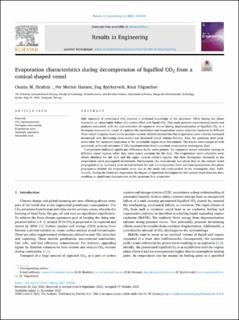| dc.contributor.author | Ibrahim, Osama Kabbashi M. | |
| dc.contributor.author | Hansen, Per Morten | |
| dc.contributor.author | Bjerketvedt, Dag | |
| dc.contributor.author | Vågsæther, Knut | |
| dc.date.accessioned | 2022-03-17T11:51:35Z | |
| dc.date.available | 2022-03-17T11:51:35Z | |
| dc.date.created | 2021-11-25T17:58:11Z | |
| dc.date.issued | 2021 | |
| dc.identifier.citation | Ibrahim, O. M., Hansen, P. M., Bjerketvedt, D. & Vågsæther, K. (2021). Evaporation characteristics during decompression of liquified CO2 from a conical-shaped vessel. Results in Engineering, 12, Artikkel 100304. | en_US |
| dc.identifier.issn | 2590-1230 | |
| dc.identifier.uri | https://hdl.handle.net/11250/2985810 | |
| dc.description.abstract | Safe transport of pressurized CO2 requires a profound knowledge of the processes' effect during the phase transition on catastrophic failure of a tanker filled with liquid CO2. This study presents experimental results and analyses associated with the characteristics of expansion waves during depressurization of liquified CO2 in a divergent cross-section vessel. It explores the rarefaction and evaporation waves velocities analyzed in different three vessel's regions based on the pressure records. Results showed that the evaporation wave velocity increased downward with decreasing cross-section and increased liquid volume fraction. Also, the upstream state properties after the isentropic expansion in the metastable region were determined. The results were compared with previously achieved outcomes of CO2 decompression from a constant cross-section rectangular duct. Comparisons indicated significant differences in the wave pattern. So, expansion waves velocities varying in different vessel regions while they were nearly constant for the duct. The evaporation wave velocities were nearly identical for the duct and the upper conical vessel's regions. But their divergence increased as the evaporation wave propagated downwards. Furthermore, the downstream two-phase flow in the conical vessel propagated in an increased cross-section toward the exit. In comparison, there was non-spontaneous two-phase propagation behind the evaporation wave due to the small exit cross-section in the rectangular duct. Additionally, during the isentropic expansion, the degree of superheat was higher for the conical vessel than the duct, resulting in significant discrepancies in the upstream flow properties. | en_US |
| dc.language.iso | eng | en_US |
| dc.rights | Navngivelse 4.0 Internasjonal | * |
| dc.rights.uri | http://creativecommons.org/licenses/by/4.0/deed.no | * |
| dc.title | Evaporation characteristics during decompression of liquified CO2 from a conical-shaped vessel | en_US |
| dc.type | Peer reviewed | en_US |
| dc.type | Journal article | en_US |
| dc.description.version | publishedVersion | en_US |
| dc.rights.holder | © 2021 The Authors. | en_US |
| dc.source.volume | 12 | en_US |
| dc.source.journal | Results in Engineering (RINENG) | en_US |
| dc.identifier.doi | https://doi.org/10.1016/j.rineng.2021.100304 | |
| dc.identifier.cristin | 1959336 | |
| dc.source.articlenumber | 100304 | en_US |
| cristin.ispublished | true | |
| cristin.fulltext | original | |
| cristin.qualitycode | 1 | |

